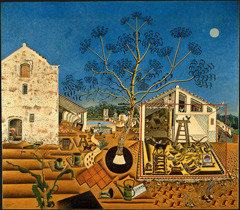Joan Miro'
dal 5/5/2011 al 11/8/2011
Segnalato da
5/5/2011
Joan Miro'
National Gallery of Art, Washington
Brings together some 80 paintings, works on paper, and sculptures drawn from his entire career, the exhibition explores Miro's immersion in issues of Catalan identity and anarchism, which appeared in his work early on as a response to contemporary events and remained with him throughout his life. The exhibition presents these themes through three principal periods: the defining of Catalan identity, 1920s; the response to the Spanish Civil War and the fall of France, 1936-1941; and the demise of Franco's regime, 1968-1975.

Joan Miró's (1893–1983) affection for his native Catalonia and his passionate response to one of the most turbulent periods in European history will be examined in the first exhibition of the artist's work at the National Gallery of Art, Washington. On view in the East Building from May 6 to August 12, 2012, Joan Miró: The Ladder of Escape will bring together some 80 paintings, works on paper, and sculptures drawn from his entire career.
The exhibition was organized by Tate Modern, London, where it is on view through September 11, 2011, in collaboration with Fundació Joan Miró, Barcelona, which will present it from October 14, 2011, to March 25, 2012, and in association with the National Gallery of Art, Washington.
Immediately following its London showing, the triptych Mural Painting I–III (1962), on loan from a private collection, will be installed in the East Building in September 2011—eight months in advance of the exhibition opening.
Two works central to the exhibition tour are from the Gallery's collection: The Farm, (1921–1922), a gift of Mary Hemingway, and Head of a Catalan Peasant (1924), a gift of the Collectors Committee.
“Telling the story of Miró's life and the times that he witnessed reveals a dark intensity to many of his works. Behind the engaging innocence of his style lie a profound concern for humanity and a sense of personal and national identity,” said Earl A. Powell III, director, National Gallery of Art, Washington. “The Gallery is honored to be the only U.S. venue for this landmark exhibition, and we are grateful to the many lenders, both public and private, who made the exhibition possible.”
The exhibition is made possible through the generous support of the Anna-Maria and Stephen Kellen Foundation.
Additional support is provided by Buffy and William Cafritz.
The Exhibition
Counted among the most important modern artists, Joan Miró used a language of symbols and a range of techniques that reflect his personal vision, sense of freedom, and boundless energy. Joan Miró: The Ladder of Escape will explore his immersion in issues of Catalan identity and anarchism, which appeared in his work early on as a response to contemporary events and remained with him throughout his life.
The exhibition will present these themes through three principal periods: the defining of Catalan identity, 1920s; the response to the Spanish Civil War and the fall of France, 1936–1941; and the demise of Franco's regime, 1968–1975.
Miró's early paintings of his parents' farmhouse in the village of Montroig establish his view of Catalan identity. This landscape was a continual source of inspiration. Critical works from this period include Vegetable Garden with Donkey (1918) and The Farm, a painting that Miró came to regard as a key work in his career.
Though not of the peasantry, Miró identified the peasant as emblematic of Catalan nationalism. In the painting series Head of a Catalan Peasant (1924–1925), Miró rendered the face and body of the figure as symbols (including the peasant's barretina). His self-identification with this figure is key to understanding the position that he adopted both locally and internationally in the 1920s and that resonated in the political turmoil of the following decade. The exhibition in Washington will bring together several canvases in the series.
Working in Barcelona and Paris, Miró was well aware of the tumult surrounding the Spanish Civil War and the first months of World War II. The exhibition will showcase extraordinary works from this period—including the series Constellations, one of which is The Escape Ladder (1940), and the print series Barcelona (1942–1944)—which draw upon political caricature as a form of resistance.
Under the political restrictions of Franco's Spain, Miró remained a symbol of international culture but was unable to make explicit his political views. Miró's grand abstract paintings of the late 1960s and early 1970s became a mark of resistance and integrity in the final years of the regime, which were a period of intense self-examination for Miró.
Curators and Catalogue
The exhibition is curated by Marko Daniel and Matthew Gale, Tate Modern, in collaboration with Teresa Montaner,curator, Fundació Joan Miró. It is coordinated at the National Gallery of Art, Washington, by Harry Cooper, curator and head, modern and contemporary art.
Published by Tate Publishing, the exhibition catalogue includes essays by Daniel, Gale, and Montaner, with contributions by Christopher Green and Robert S. Lubar. The 240-page catalogue will be available for purchase in the Gallery Shops in hardcover and softcover in early 2012. To order, please visit our website at shop.nga.gov; call (800) 697-9350 or (202) 842-6002; fax (202) 789-3047; or e-mail mailorder@nga.gov.
Press Office
National Gallery of Art
2000B South Club Drive
Landover, MD 20785
phone: (202) 842-6353 e-mail: pressinfo@nga.gov
Deborah Ziska
Chief of Press and Public Information
(202) 842-6353
ds-ziska@nga.gov
Image: Joan Miró, The Farm, 1921-1922
oil on canvas
National Gallery of Art. Gift of Mary Hemingway
Opening May 6 2011
National Gallery of Art
National Mall between 3rd and 9th Streets at Constitution Avenue NW
open Monday through Saturday from 10:00 a.m. to 5:00 p.m. and Sunday from 11:00 a.m. to 6:00 p.m.
The Gallery is closed on December 25 and January 1.
admission free



